Customer service is a far too often forgotten component of a well-rounded digital marketing program.
It represents the fine line between having a one-time customer and having a repeat customer who is happy to spread the news of your brand’s products and services.
Customer service bridges the gap between a purchase and a return customer by providing help, answering questions, and handling complaints or issues.
Unfortunately, departments often prioritize other marketing or sales activities, leaving them understaffed and unhappy.
Thankfully, Artificial Intelligence, or AI, is changing the name of the game regarding customer service.
AI makes new tools, platforms, and techniques for managing customer requests possible.
In this article, we’ll discuss how AI is changing customer service, how it benefits customer service teams, and how to use AI in customer service applications today.
How AI is Changing the Face of Customer Service
For generations, the quality of customer service behind a brand has been determined by employee headcount and bandwidth.
Customer service representatives struggled to manage workloads with the influx of questions and calls from customers.
AI has completely changed the way customer service runs in a business setting.
With AI, customer service departments can free up their days from repetitive and time-consuming tasks.
With extra time, customer service representatives have time to do more and improve the customer experience.
When customers feel like they have more connections to your brand and that their concerns are quickly and efficiently addressed, they are more likely to return.
Encouraging repeat customers is the most effective method to manage marketing expenses, garner favorable brand feedback, and boost sales.
What are the Top Benefits of Knowing How to Use AI in Customer Service?
Understanding how to use AI in customer service can help your brand grow and keep your customers delighted.
AI offers numerous benefits to customer service teams by assisting them in tasks they may not have the time or ability to manage independently. This fosters a better work culture and ensures that efforts are on important tasks.
Personalization
Personalization is a common buzzword in marketing.
In short, personalization refers to the practice of tailoring messaging, offers, content and experiences for audience segments based on key identifying factors.
It ahelps to increase customer satisfaction and deliver what each customer is looking for, rather than treating every person the same.
AI helps in personalization efforts by taking data and generating buyer personas which it can then connect products and services with, making each customer’s experience unique.
A common example of this is a recommended viewing list from a streaming service or a related products list email from a retailer.
Rich Productivity
Employee productivity and efficiency are key elements of any successful business.
Not only does it ensure that everyone is doing their job, it means that employees feel satisfied in their positions.
AI automates the daily recurring or repetitive tasks that take up much of our productive time.
When certain tasks can be taken off the plates of customer service teams, they have more time to focus their productivity on more important tasks that grow the business.
Speedy and Always-Available Response
Is there anything worse than calling a customer service line and spending hours on hold?
Or typing in a live chat box to speak with a salesperson and being left waiting for a response?
Customers expect speedy responses at any time of the day.
AI helps to improve the customer experience with always-available bots that have immediate answers.
While these are obviously more limited than a real personal conversation, they still provide a wide array of possibilities to answer questions and let customers know they are being heard.
Multichannel Support
People want to reach your brand on their favored platforms.
Just having a Facebook bot or a website plug-in isn’t enough to satisfy today’s customers.
Thankfully, many chatbots and customer support AI platforms have built-in multichannel capabilities, meaning you don’t have to recreate your experience across different platforms.
After setting up your bot, the same program will be implemented across your network.
Reduction in Churn Rate
“Churn” refers to the number of customers that leave your brand to go to a competitor.
While there are many reasons for churn, like a better product or price, there is a significant amount of churn as a result of a bad customer experience.
AI can improve the overall quality of experience your customers have while on your website or social platforms, which in turn reduces the churn rate in your company.
Examples of AI Tools to Improve the Customer Experience
Today, you have access to several AI tools which can help improve the customer experience, including the five discussed below.
1. Zowie
You can easily get started answering users’ most frequently asked questions by automating the process with the aid of Zowie, the AI-powered software and chatbot provider.
Zowie allows you to easily scan your current FAQ page, creating a knowledge base that the chatbot will use for your customers.
As an additional bonus, the AI software can analyze your questions and apply the resulting answers to differently worded variations.
The chatbot will provide answers quickly to customers and can do so in over forty languages. It is easy to set up and can be integrated with various software, including Instagram, Facebook Messenger, and Shopify.
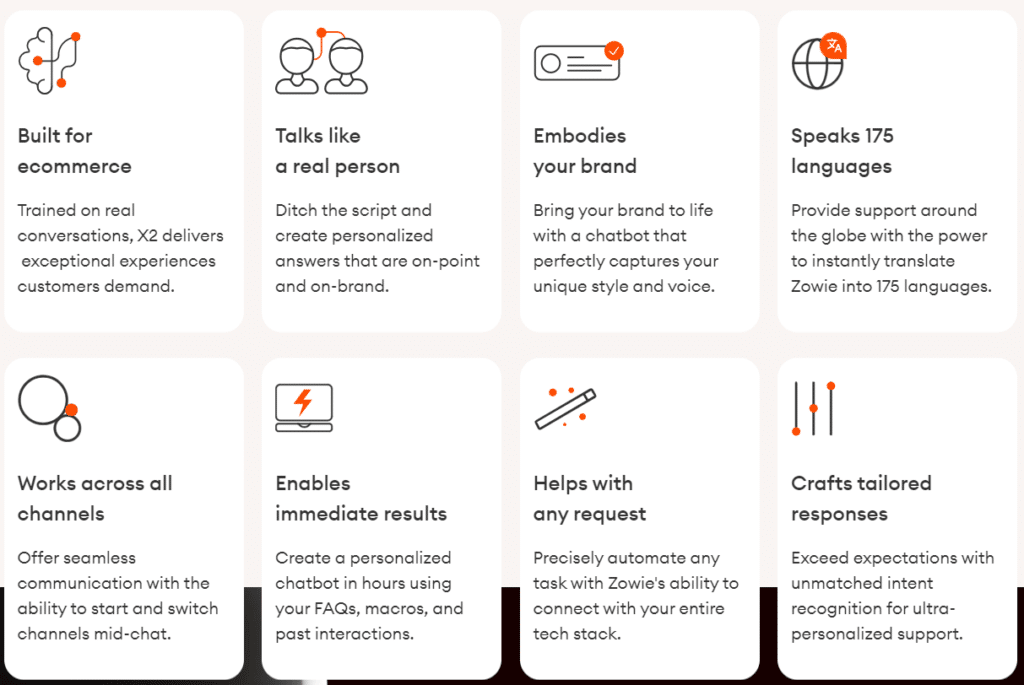
2. Aisera AI
The Aisera AI chatbot integrates with the various systems you may already have in place to deliver top-notch customer service. You can use it to help effectively cut down on wait times with its automatic interaction with customers.
Aisera AI integrates with various case management, ticketing, or CRM systems, including Salesforce and Zendesk, to escalate a customer to a live agent. This, in turn, can empower your support agents, allowing them to focus on the more unique issues that require direct interaction.
3. Yuma AI
A variety of AI tools are available today to help speed up response times, including self-service chatbots and voicebots, agent-assist solutions, conversational analytics, and AI-driven coaching.
One tool, in particular, that is beneficial for those on Shopify is Yuma, which provides an AI Ticket Assistant to help speed up procedures for responding to customers.
This software can reply in writing to customers’ inquiries, adjust writing styles when perceived to be necessary, automatically translate into 15 different languages, and also connect with your help-desk software.
4. Freshdesk
If you are searching for a tool to help you manage your customer service process across different channels, including any combination of live chat, emails, mobile apps, and social platforms, Freshdesk can be advantageous and time-saving.
With it, you can better automate your customer service workflow and provide your agents with a 360-degree view of each customer to better facilitate resolutions. It can also route tasks to where they can best be supported more efficiently, helping reduce call wait times for your customers.
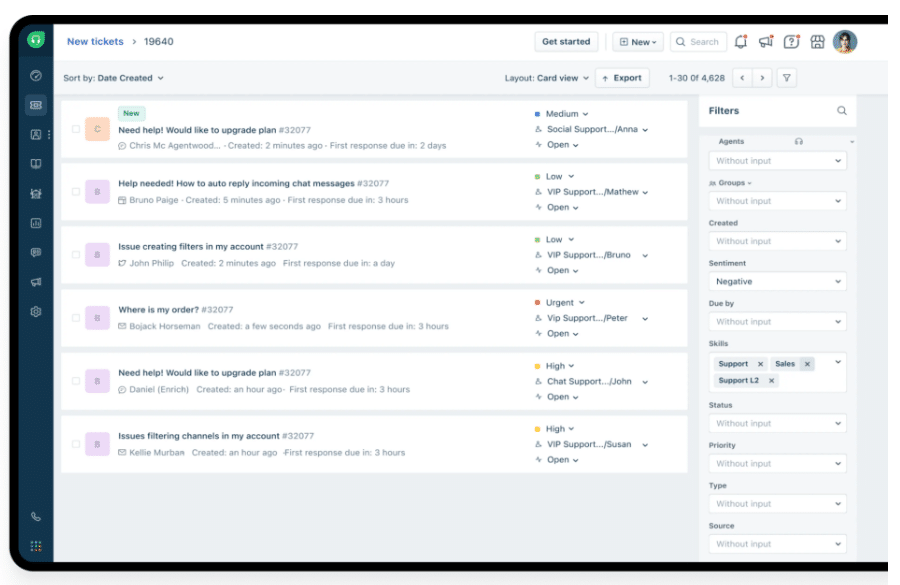
5. Eddy AI
To streamline your customer support process, Eddy AI Assistant may be all you need. Its AI-powered chatbot can be integrated seamlessly with your different channels, including websites, social media pages, messaging apps, and mobile applications.
The Eddy AI Assistant meets customers at the initial point of contact, answering already established FAQs. For those questions not on that list, Eddy AI transfers the customer to a live customer service agent.
This platform also gathers detailed analytics on customer engagement and more, providing you with clues as to how to improve your customer service, marketing, and sales efforts.
Factors to Consider When Choosing an AI Solution for Customer Service
When deciding on an AI customer service solution, it’s crucial to weigh various factors to ensure you make the best choice for your business.
Compatibility
Firstly, compatibility with your existing systems is paramount. Look for a solution that seamlessly integrates with your current software and infrastructure to avoid disruptions and maximize efficiency.
Scalability
Scalability is another essential consideration. Your chosen solution should have the capacity to grow alongside your business, accommodating increasing volumes of customer interactions without sacrificing performance or reliability.
Ease of implementation
Ease of implementation and configuration is key to getting up and running quickly. Pick a solution that offers straightforward setup processes and intuitive user interfaces, minimizing the time and resources required for deployment.
Customization options
Customization options are also important. Your AI customer service solution should be flexible enough to adapt to your unique business requirements and workflows.
Look for features that allow you to tailor the solution to meet your specific needs, whether it’s customizing chatbot responses or configuring automated workflows.
Pricing
When evaluating pricing, consider the overall value proposition. While cost is certainly a factor, it’s essential to weigh it against the features, functionality, and benefits offered by the solution.
Look for transparent pricing structures and consider the long-term return on investment.
Customer support
Finally, robust customer support is crucial. Pick a vendor that provides excellent customer service and support resources, including responsive technical support, comprehensive documentation, and user training.
Having reliable support ensures that any issues or concerns can be addressed promptly, minimizing disruptions to your customer service operations.
By carefully considering these factors, you can select an AI customer service solution that aligns with your business goals and delivers tangible benefits in efficiency, productivity, and customer satisfaction.
Here’s a table that summarizes the main factors to consider:
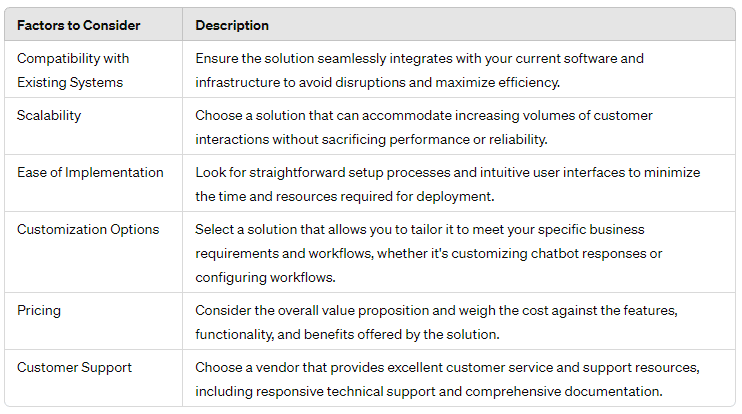
5 Ways to Use AI in Customer Service Experiences
Now that you understand the benefits of knowing how to use AI in customer service experiences, let’s take a deep dive into some of the ways your business can utilize machine learning.
Outsiders to AI might think that it requires dedicated teams of developers and engineers, but the opposite is true.
AI can be woven into your marketing strategies in many ways with simple tools you might already have access to with your software.
1. Solving Users’ Most Frequent Questions
Customers will often have similar or even the same questions regarding your brand, your products, and services, or your policies.
While creating a FAQ page on your brand’s website is always a best practice, sometimes customers want to get that information in other ways.
Chatbots and AI communication tools can connect customers to the answers they are looking for in a friendly, interactive, and engaging format.
Many customers prefer the experience of a conversation, even if it’s with a bot.
When your customer service teams aren’t fielding the same questions every day, it frees up a lot of time in the day to focus on other, high-level tasks.
Both customers and your customer service team will benefit from bots.
2. Learning Customer Behavior Patterns
While your marketing and sales efforts are taking in a large amount of data, parsing through all that data and gaining actionable insights isn’t as easy.
AI can go through massive data sets and pull out information related to customer behavior patterns.
When you understand the patterns exhibited by your customers, you can better predict the solutions or alternatives that will appeal to your audiences, as well as be able to predict important events and trends.
One way to accomplish this is with the use of an AI-powered solution called Ion.
While this platform provides you with the ability to easily create interactive content for your potential and existing customers, it can also do more.
Ion is an AI-powered solution for learning, measuring, and generating insights into your customers’ behavior patterns. With it, you can learn how your customers are engaging with your interactive customer service content by way of the platform’s clear and accurate reporting abilities.
It also easily integrates with your CRM or automation tool, and you can export the data for review and use by your sales and marketing teams.
3. Speeding Up Response Times
In today’s fast-paced world, customers don’t want to wait for answers.
When a customer sends a message through a chatbot or a customer service form, they want an immediate response to their concern.
If you can’t respond promptly to customer needs, they may quickly become frustrated with the experience and either switch to a competitor or lose faith in your team’s customer service capabilities.
Responding quickly is key to increasing customer satisfaction and AI can help with that.
Whether it’s a chatbot that talks to the customer in place of a representative or an automated response that directs customers to an after-service line, there are many ways AI helps speed up response times.
4. Measuring Customer Wait Times
Companies can use AI not just for shortening the gap between responses in chatbots — it can also use AI to measure wait times for customers online, on the phone, or even in person.
AI can measure how long your customers wait for responses in live chats, calculate hold times, and determine the time it takes for a customer to be seen after checking in for an in-person appointment.
When you understand how long customers are waiting, you can start to strategize on how to improve and expedite to make the experience better for your audience.
5. Capturing Large Amounts of Data
While forms or purchase histories can provide some data, AI can dive much deeper and capture large amounts of data.
AI tools can mine complex data that most team members wouldn’t know how to interpret or even collect.
Even more so than capturing data, AI can comprehend and organize the data into actionable steps and clear insights.
AI finds patterns that people won’t notice and transforms complicated data sets into easy reports.
Challenges of Using AI In Customer Service
Before getting started on incorporating AI into your customer service process, it will also be beneficial to gain a sense of the various existing challenges. The most common ones are listed below.
Identifying where to insert AI
Before adding AI solutions into your customer service process, you must first fully understand your customers and determine where to insert AI most effectively.
You’ll need to determine these first, finding where to introduce AI solutions to help both you and them without going overboard.
Anticipating escalation of customer needs
Over the last few years, customers have become increasingly comfortable with self-service options on digital channels. Automated first points of contact are increasingly being accepted as the norm.
However, when it comes to additional or more complex customer needs, customers prefer human interaction, whether through a call center or assisted chats online.
Where the challenge comes in is that companies today must anticipate where the escalation of customer needs occurs and how to transition. This adds a degree of complexity, as the mix of AI and human solutions must intertwine at some point.
Handling increasing customer expectations
As with shopping online or using the self-checkout at the local grocery store, consumers today are becoming more comfortable and reliant on quick, straightforward, self-service options and fast response times.
The downside to all of this is that it can result in rising expectations of other self-service options or faster responses from human agents within your company.
If you don’t continue to progress in how your AI-powered or assisted solutions function, you will be unable to meet those increasing customer expectations and suffer the consequences.
It’s the double-edged sword of providing too much vs. providing too little, with the potential for failing to meet your customers’ needs and expectations either way.
Meeting the expenses of implementation
For implementing AI-powered or AI-assisted solutions, costs can be high and, for some, even prohibitive.
Every company will need to consider this, measuring potential costs against the expected benefits.
Another factor that will contribute to the cost of implementing and using AI in customer service is the need for the required infrastructure. Since AI solutions require high volumes of data to be efficient, your business must have the infrastructure to facilitate this.
Maintaining a trained workforce for AI-assisted customer service
While AI may be the wave of the future, it is not at a point where companies can dismiss human oversight. You will need to ensure you maintain enough customer service employees to keep everything in check and keep the service efficient and acceptable.
Yet, with such bold changes in the workplace, you now face the dilemma of potentially lacking enough experienced customer service employees. These essential workers will need to continue to monitor customer service outcomes while also supporting the AI programs and tools you are using.
Today, the labor market is tight when it comes to finding workers for these roles. For those you hire, you’ll likely need to train them to understand how your customer service process integrates AI and human solutions. This training will naturally incur costs and can be highly time-consuming, especially if you experience a high turnover rate.
Wrap-Up: AI is Changing the World of Customer Service
And it’s also making things easier and more efficient for customer representatives and teams.
With new tools, techniques, and applications for AI and machine learning, marketing teams are changing the ways in which they operate and moving forward with digital transformations.
If you are wondering how AI can help improve your marketing efforts and the overall customer service experience, start with a look at what Ion can offer. Request a demo today!
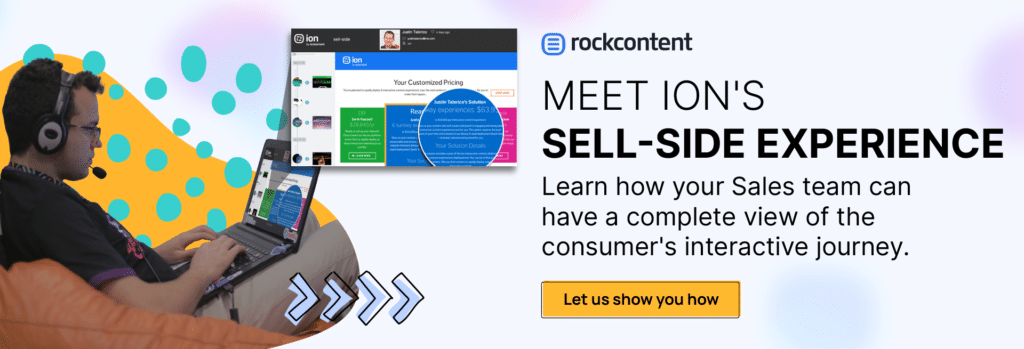
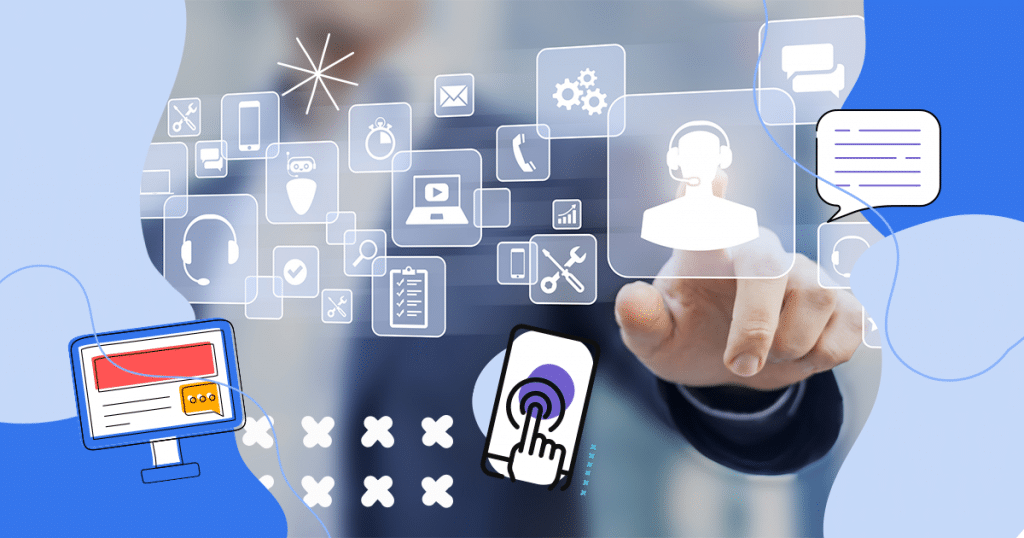

![[Rock NA] State of Marketing Reports 2024 – Comkt Hubspot State of Marketing Report 2024](https://rockcontent.com/wp-content/uploads/2022/07/Banner-Fino-Rock-Convert-2500-%C3%97-500-px-19.png)







